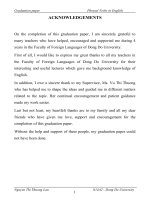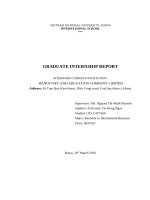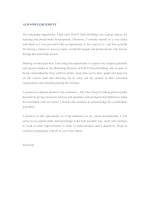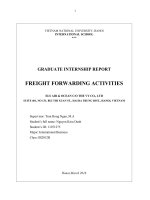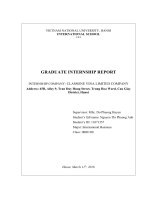Báo cáo thực tập tiếng anh GRADUATE INTERNSHIP REPORT INTERNSHIP COMPANY CLASSONE VINA LIMITED COMPANY
Bạn đang xem bản rút gọn của tài liệu. Xem và tải ngay bản đầy đủ của tài liệu tại đây (409.18 KB, 38 trang )
VIETNAM NATIONAL UNIVERSITY, HANOI
INTERNATIONAL SCHOOL
***
GRADUATE INTERNSHIP REPORT
INTERNSHIP COMPANY: CLASSONE VINA LIMITED COMPANY
Address: 45B, Alley 9, Tran Duy Hung Street, Trung Hoa Ward, Cau Giay
District, Hanoi
Supervisor: MSc. Do Phuong Huyen
Student’s full name: Nguyen Thi Phuong Anh
Student’s ID: 11071357
Major: International Business
Class: IB2012B
Hanoi, March 11th, 2016
2
ACKNOWLEDGEMENTS
On my internship report, it is my privilege to thank all the people who made this period an
unforgettable experience in my life.
First, I am very thankful for the board of director of CLASSONE VINA, who gave me the
chance to work in a brand new environment
.
Second, I should thank to the staffs of CLASSONE VINA for supporting and providing me
the opportunity to have a great internship period. Especially, I am very grateful to my
sponsor - Ms. Tran Thi Thu Huong – for providing me appropriate guidance and training
within these 6 weeks.
And last but not least, I also appreciate my supervisor – Ms. Do Phuong Huyen – for the
efforts to supervise and give me the direction to explore a new environment. Thanks to her,
I have crucial comments to successfully complete this report.
Hanoi, March 11th, 2016
Nguyen Thi Phuong Anh
3
ABBREVIATIONS
BCR
Dept.
HR
HVAC
IT
Ltd.
PM
R&D
SMBA
VND
Bio Clean Room
Department
Human Resource
Heating, Ventilating, and Air Conditioning
Information Technology
Limited
Project Manager
Research and Development
Small and Medium Business Administration
Vietnam Dong
LIST OF TABLES
Number
1.1
1.2
1.3
2.1
2.2
2.3
3.1
Name
Company general information
CLASSONE’s History
BCR Services
CLASSONE’s Revenues
CLASSONE’s Corporate tax
CLASSONE’s Financial Activities
Schedule of internship
Page
5
6
9
20
21
23
24
LIST OF FIGURES
Number
1.1
1.2
2.1
2.2
2.3
Name
CLASSONE Organizational Structure
CLASSONE VINA Organizational Structure
Operating process
Product positioning
Company capital Structure 2014 - 2015
Page
7
8
11
12
19
4
Contents
5
Part I - INTERNSHIP REPORT
CHAPTER 1: Overview of CLASSONE
CLASSONE is a Korean corporation established on September 30th, 2003. With the mission
of quality management, the company began with machine facility construction business.
CLASSONE has become the leading company in the clean room facilities field, providing
suitable solutions for industrial clean room, bio clean room and cleaning equipments.
CLASSONE VINA is the Vietnamese subsidiary of CLASSONE, which is one of many
tools to enhance its existence in Southeast Asia market.
1.1. Company outline
Table 1.1: Company general information
Company name
CLASSONE Co. Ltd.
CEO
Lee Jaewon
Establishment date
September 30th, 2003
March 14th, 2014 (Vietnam)
Location
Head office: 509 Cheohye rodeo plaza, Gozan-dong, Ansan
City, Korea
Vietnam: 45B, Alley 9, Tran Duy Hung Street, Trung Hoa
Ward, Cau Giay District, Hanoi
Business
Manufacturing, Construction, Wholesale, etc.
Telephone
+84-4-6259-5511
Website
www.class1.co.kr
Business license
011043002251
Tax code
0106493556
(Source: www.class1.co.kr)
6
1.2. Company History
Table 1.2: CLASSONE History
Date
Activities
30/09/2003
Establishment of CLASSONE Inc
02/10/2003
Opening the office of the headquarters
26/08/2004
Registration of construction industry
30/09/2004
ISO9001 Certification acquisition
02/09/2004
Joining Korea Mech. Const. Contractors Association
17/04/2005
Increase of capital (250 million won)
15/02/2006
Joining Korea Printed Circuit Association as a regular member
04/09/2006
PCB facility and clean facility manufacturing factory registration (
Ansan City)
Shenzen China Mooneup interior limited company trade basic
contract
Establishment of a research institute attached to the company
10/11/2007
10/06/2008
28/11/2008
12/06/2009
18/06/2009
Approved as small-and-medium sized company of management
innovation
Execute a sale contract of JMI in Vietnam and Cambodia
23/06/2009
Approval of Welsum Inc. the Ministry of Agriculture in Japan for
heat food process facility
ISO14001 Certificate acquisition
07/08/2010
Increase of Capital (400 million won)
01/06/2011
Joining KOHEA
26/07/2011
Application of patent for mushroom growing facilities
19/03/2012
Shanghai, China office
14/03/2014
Set up corporation in Vietnam
12/06/2015
Selected as High Growth (Gazelle type) Company by SMBA
1.3. Mission and Core value
• Mission: Trusted quality, the optimal delivery and the best system.
7
• Core values:
- Sincerity: We make the best effort with sincerity for clients.
- Harmony: With harmony of all staff members, we move toward the common goal of
customers and the company.
- Loyalty: Based on trust and loyalty, we show the faithfulness of the company.
1.4. Organizational structure
1.4.1. CLASSONE Corporation
Figure 1.1: CLASSONE Organizational Structure
PRESIDENT
Foreign country
R&D
dept.
China
office
Vietnam office
Laboratory
Cleanroom business
Equipment
Management support
dept.
business dept.
team
Technical sales team
Technical sales team
Personnels/ General
affairs
Technical team
Production team
Accounting/ Finance
PM business team
Customer service
team
Customer service
team
(Source: www.class1.co.kr)
1.4.2. CLASSONE VINA
Figure 1.2: CLASSONE VINA Organizational Structure
8
Board of Director
Contruction & Design
Dept.
HR Dept.
Accounting/Finance
Dept.
Administrative Dept.
(Source: CLASSONE’s Yearbook, 2014)
1.5. Products and targeted customers
1.5.1. Industrial Clean room
a. Definition
“Clean room means the space where floating corpuscle in the air is maintained
below the certain degree of cleanliness; degree of cleanliness required for supplied
material, medicine and water is maintained and management is conducted regarding
temperature, humidity and pressure.”
Classone, 2010
b. Clean room service
- Suggest best solution for customer manufacturing environment, based on correct
understanding on product and process of customer.
- Fully equipped with long experience and expertise in industrial manufacturing:
electric and electronic (such as semiconductor, LCD, PCB), precision machines, optics,
printing, chemicals and film manufacturing.
- Provide service for Digitech (May,2014), Samkyung (June, 2014), INM
(June,2015), BHFlex (November,2015), and Orchem (December, 2015).
1.5.2. Bio clean room - BCR
a. Definition
9
“BCR means the room which controls biological particles (living particles) and nonliving particles in order to meet particular standard for a special purpose and also controls
temperature, humidity and pressure indoor depending on specific needs.”
b. BCR service
- Create optimal environment for pharmaceutical, laboratory and food manufacturing
those require special environmental control and fully compliance to regulations.
-
Provide hospital Total Clean System covers whole hospital areas including
operating room, isolation room, ICU and aseptic room.
Table 1.3: BCR Service
GMP –
Practice
Goods
Manufacturing
Optimized pharmaceutical
fully compliance with GMP
facility
GLP – Goods Laboratory Practice
Optimized laboratory solution to
variable requirements for laboratory
animals and biohazards
Hospital Solution
Total solution for whole hospital
operation including operating room,
aseptic room and HVAC system
HACCP (Hazard Analysis and
Critical Control Point)
Safe and clean, tighter contamination
controlled
food
manufacturing
environment
1.5.3. Clean equipments
Highly skilled engineers develop, design and manufacture core equipments. This
assures further customer satisfaction by providing high technology system with cost
efficiency, also optimized to varying requests of customers. Equipments include:
• Air control unit
• Air shower (normal and special type)
10
•
•
•
•
•
•
•
•
•
•
•
•
•
•
•
•
.
Bag filter type Dust collector
Fan Filter Unit (FFU)
Pass box (standard and shower type)
Clean bench (horizontal and vertical type)
Clean booth (standard and thin type)
HEPA Filter Box
Relief damper
Medical Fan Unit
Air Handling Unit
Environment Test Devices
Constant temperature and Humidity chamber
Cooling system and Refrigerator
Condensing Unit
Blower Filter Unit
Dry type Dehumidifier
Mushroom Growing Facility
11
CHAPTER 2: COMPANY OPERATING ACTIVITIES
2.1. Operating process
Step 1: After receiving the clean room design requirements, professional engineers
will measure the parameters in the clean room installation position.
Step 2: Based on the structure, size, pressure and level of air circulation, we make the
complete design for the clean room.
Step 3 Building clean room with specialized equipment and materials with strict
requirements in order to ensure the tightness, pressure, and standard amount of dust in the
room.
Step 4: Conducting tests for usage
Step 5: Performing warranty (if needed)
Figure 2.1: Operating process
Control and make
Start
Implement the plan
Receive requests from the
Make a specific
Handover the
customer
plan
project
Design and send
Negotiate and sign
quotation
the contract
assessments
Guarantee
Finish
(Source: CLASSONE’s Yearbook, 2014)
12
2.2. Supply chain activities
For clean equipments, CLASSONE follows make-to-stock strategy which allows producing
products for immediate sale and delivery, in anticipation of demand (Sanders, 2013). It also
provides shortest delivery lead time.
Figure 2.2: Product positioning
Processing
Assembly stock
Inventory stock
Shipping
(Source: CLASSONE’s Yearbook, 2014)
2.3. Management activities
The operating activities in Vietnamese office are managed and controlled by Korean
expatriates.
2.3.1. Board of Director:
- CEO – Mr. Lee Jaewon
• Taking primary responsibility for the operating results of the company.
• Deciding competitive strategies to meet company strategic goals
• Having direct meeting with senior partners.
- Vice director – Mr. Lee Junjae: supports the director in operation control and management.
2.3.2. Human resource department
• Recruit employees.
• Training new employees to fit company culture and job requirements.
• Examine staffs’ compliance with firm’s rules and regulations.
• Maintain and enhance employees’ performance by planning, implementing and
evaluating human resources program.
2.3.3. Construction and design department
• Do engineering surveys and measurements
• Design clean room and BCR in accordance with customers’ demand
• Provide consultation for customers
• Construct based on the determined design
13
2.3.4. Accounting and Finance department
Billings: assembles information from the shipping and customer order departments to
create invoices that are sent to the company's customers.
Collections: keeps track of overdue invoice payments from customers, and uses a variety
of methods to extract payment from them, including dunning letters, phone calls, and
attorney letters.
Financial statements: creates adjusting journal entries to bring the company's initial
financial results into compliance with the applicable accounting framework, writes
footnotes to accompany the financial statements, and releases financials following the
end of each reporting period.
Internal reporting: provides considerable value to a business by calculating the
profitability of various products, product lines, services, customers, sales regions, stores,
and so forth. The areas of analysis may change on a regular basis, so that management
can view different aspects of the business, with an emphasis on improving financial
results.
Payables. The payables staff collects supplier invoices and employee expense reports,
verifies that the billed amounts are authorized for payment, and issues payments to
recipients on scheduled payment dates.
Payroll: collects time worked information from employees, as well as pay rate
information from the human resources department, calculates tax and other deductions
from employee pay, and issues net pay amounts to employees, either in cash or via
checks, pay cards, or direct deposit.
Taxes: estimates the amount of taxable income that the business is likely to generate,
and periodically remits income tax payments to the government, based on this estimated
amount.
2.3.5. Administrative department
• Draft the contracts
• Update records in the computer system.
• File, label, organize and respond to requests for files from the supervisors or other
department
14
• Communicate with clients and outside vendors.
2.4. Accounting activities
The significant accounting policies, which have been adopted by the Company in the
preparation of financial statements, are as follows:
Estimates
The preparation of financial statements in conformity with Vietnamese Accounting
Standards, Vietnamese Accounting System and prevailing accounting regulations in
Vietnam requires management to make estimates and assumptions that affect the reported
amounts of assets, liabilities and disclosures of contingent assets and liabilities at the date of
the financial statements and the reported amounts of revenues and expenses during the
financial year.
Financial instruments
Initial recognition
Financial assets: At the date of initial recognition, financial assets are recognized at cost
plus transaction costs that are directly attributable to the acquisition of the financial assets.
Financial assets of the Company comprise cash and cash equivalents, trade receivables, and
financial investments.
Financial liabilities: At the date of initial recognition, financial liabilities are recognized at
cost net of transaction costs that are directly attributable to the issue of the financial
liabilities. Financial liabilities of the Company comprise trade and other payables, accruals
and borrowings.
Re-measurement after initial recognition
Currently, there are no requirements for the re-measurement of the financial instruments
after initial recognition.
Cash and cash equivalents
15
Cash and cash equivalents comprise cash on hand, demand deposits and short-term, highly
liquid investments that are readily convertible to known amounts of cash and which are
subject to an insignificant risk of changes in value.
Short-term financial investments
Short-term financial investments comprise time deposits with the duration from over three
months to less than one year.
Receivables and provision for doubtful debts
Provision for doubtful debts is made for receivables that are overdue for six months or
more, or when the debtor is in dissolution, in bankruptcy, or is experiencing similar
difficulties that may be unable to repay the debts.
Inventories
Inventories are stated at the lower of cost and net realizable value. Cost comprises direct
materials and where applicable, direct labors costs and those overheads that have been
incurred in bringing the inventories to their present location and condition. Cost is
calculated using the weighted average method. Net realizable value represents the estimated
selling price less all estimated costs to completion and costs to be incurred in marketing,
selling and distribution.
The evaluation of necessary provision for inventory obsolescence follows current prevailing
accounting regulations, which allow provisions to be made for obsolete, damaged, or substandard inventories and for those which have costs higher than net realizable values as at
the balance sheet date.
Tangible fixed assets and depreciation
Tangible fixed assets are stated at cost less accumulated depreciation.
The cost of purchased tangible fixed assets comprises its purchase price and any directly
attributable costs of bringing the assets to its working condition and location for its intended
use.
16
Tangible fixed assets are depreciated using the straight-line method over the estimated
useful lives as follows:
2015
Years
Machinery and equipment
5-10
Motor Vehicles
6-10
Long-term prepayments
Long-term prepayments is comprised of the pre-operational expenses and other prepaid
expenses. These expenditures have been capitalized as long-term prepayments, and are
allocated to the income statement using the straight-line method over the period of years, 5
years and 3 years, respectively in accordance with the current prevailing accounting
regulations.
Revenue recognition
Revenue from the sale of goods is recognised when all five (5) following conditions are
satisfied:
(a) The Company has transferred to the buyer the significant risks and rewards of ownership
of the goods;
(b) The Company retains neither continuing managerial involvement to the degree usually
associated with ownership nor effective control over the goods sold;
(c) The amount of revenue can be measured reliably;
(d) It is probable that the economic benefits associated with the transaction will flow to the
Company; and
(e) The costs incurred or to be incurred in respect of the transaction can be measured
reliably.
Foreign currencies
The Company applies the method of recording foreign exchange differences in accordance
with Vietnamese Accounting Standard No. 10 (VAS 10) “Effects of changes in foreign
exchange rates”. Accordingly, transactions arising in foreign currencies are translated at
17
exchange rates ruling at the transaction date. Monetary assets and liabilities denominated in
foreign currencies are retranslated at the rates of exchange prevailing on the balance sheet
date. Exchange differences arising from the translation of these accounts are recognised in
the income statement. Unrealised exchange gains at the balance sheet date are not treated as
part of distributable profit to owners.
Provisions
Provisions are recognized when the Company has a present obligation as a result of a past
event, and it is probable that the Company will be required to settle that obligation.
Provisions are measured at the management’s best estimate of the expenditure required to
settle the obligation at the balance sheet date.
Borrowing costs
Borrowing costs directly attributable to the acquisition, construction or production of
qualifying assets, which are assets that necessarily take a substantial period of time to get
ready for their intended use or sale, are added to the cost of those assets, until such time as
the assets are substantially ready for their intended use or sale. Investment income earned on
the temporary investment of specific borrowings pending their expenditure on qualifying
assets is deducted from the cost of those assets.
All other borrowing costs are recognized in the income statement when incurred.
Taxation
Income tax expense represents the sum of the tax currently payable and deferred tax.
The determination of the tax currently payable is based on the current interpretation of tax
regulations. However, these regulations are subject to periodic variation and their ultimate
determination depends on the results of the tax authorities’ examination.
Other taxes are paid in accordance with the prevailing tax laws in Vietnam.
Auditing
CLASSONE’s financial statements are independently audited by MHD Auditing Company
Limited.
18
IT Methods
The accountants mainly use CNS Accounting Software to manage every day transactions.
2.5. Financial activities
Since CLASSONE VINA has been operating in Vietnam just for more than 2 years, this
report only analyses the financial performance of the company in the period 2014-2015.
2.5.1. Capital structure
• Investment capital of the company is VND 10.518.000.000 (equivalent to USD
500.000);
• Charter capital: VND 6.310.800.000 (equivalent to USD 300.000);
• Duration of operation: 10 years from the date of granting the Investment License.
Since the establishment, the company capital rose 2.5 times from 11.8 billion dong to 29.9
billion dong. It results from the significant increase in current liabilities.
Capital structure weights:
Figure 2.3: Company capital Structure 2014 - 2015
.
19
(Source: CLASSONE’s financial statements)
While the capital was evenly combined by Debts and Equity in 2014, it became
mainly contributed by Debts in 2015. Debts accounted for 80 percent of the capital
structure, which is similar to the general trend (72 percent) of companies in
Construction sector (Cophieu68, 2015).
Theoretically, the use of debt creates tax saving and gain income for business owner
but also raises the need of payment and create pressure on management staffs
(Phan, 2012). This will be examined further in following sections.
2.5.2. Revenue and profitability index
• The revenue of the company increased by 1.67 times from 2014 to 2015.
Table 2.1: CLASSONE’s Revenues
(Source: CLASSONE’s notes to financial statements, 2014-2015)
• Profitability index
ROA of CLASSONE VINA was 3.49 percent in 2004 (similar to the
Construction sector value) and then decreased to (-2.43) percent the year after. This
may be the consequence of the decrease in operating profits.
ROE was (-8.89) percent, which is far below the average of companies doing
business from the same sector (10 percent) (Phan, 2012).
Both indexes are under average and in the recessive trend, which seriously
affects the year-end income of business owners.
20
2.5.3. Tax expense:
The company has to pay corporate tax rate of 20 percent of all its taxable income.
While CLASSONE paid VND 51.7 millions in 2014, it did not have to pay any
corporate income tax in 2015 because of the loss before tax.
Table 2.2: CLASSONE’s Corporate Tax
(Source: CLASSONE’s notes to financial statements, 2014-2015)
2.5.4. Risk analysis
Table 2.3: Risk ratios for CLASSONE
Revenues to cash ratio
Days Revenues held in cash
Current ratio
Quick ratio
Operating cash flow to Average current
liabilities
Days Accounts Receivable
Days Inventory
Days Accounts Payable
2014
2015
11.702
31
1.681
1.596
4.354
84
1.216
0.512
0.200
96
122
52
21
Liabilities to Assets ratio
Liabilities to Shareholders’ Equity Ratio
0.539
1.169
0.799
3.974
Long-term Debt to Long-term capital ratio
0
0
Long-term Debt to Shareholder’s equity 0
ratio
Operating Cash flow to Total liabilities ratio
0
0.200
(Source: Calculated by the author)
a. Liquidity risk
• The revenues to cash ratio was 11.7 in 2014 and 4.3 in 2015. The revenues
held in cash increases from 31 days to 84 days. From the viewpoint of shortterm liquidity risk, lenders prefer a smaller revenues to cash ratio ( more cash
in the denominator) and a larger number of days revenue available as cash on
hand (Baginski et al, 2011). However, it also indicates inefficient use of
cash.
• The Current ratio and the Quick ratio were on the decreasing trend shows a
good sign of operations.
• The Days Account Receivable usually lasts under 90 days. Along with the
number of Days Account Payable of 52 days, it proves that the company is
small and has little reputation. This statement is also proved by large number
of Days Inventory and
• Nevertheless, the Operating cash flow to Current liabilities ratio was only 0.2
while experts found that a ratio of 0.4 or more was common for a typical
healthy manufacturing firm (Baginski et al, 2011).
=> Hence, CLASSONE VINA displays a significant liquidity risk.
b. Solvency risk
• Because the company does not have any long-term liabilities, it faces less
long-term solvency risk.
22
• Overall, the Liabilities to Assets ratio and the Liabilities to Shareholders’
Equity ratio followed an upward trend as a result of supplying more money
from loans and trade payables.
• The Operating cash flow to Total Liabilities ratio was 0.2 which is common
for a financially healthy ratio. In another hand, if we take a further look at the
formula:
If CLASSONE VINA borrows long-term liabilities, this ratio will become less
than 0.2, which indicates a solvency risk.
=> The company faces a considerable solvency risk.
2.5.5. Investment activities
Table 2.4: CLASSONE’s financial activities:
(Source: CLASSONE’s notes to financial statements, 2014-2015)
The company gain some financial in come from foreign bank interests and
foreign exchange difference. Nevertheless, the number seems quite small
compared with the loss from foreign exchange risk.
23
24
CHAPTER
3:
INTERNSHIP
GOALS,
ASSIGNED
TASKS
AND
PERFORMANCE
3.1. Internship goals
• To approach potential working environment and decide whether it meets
career wishes and interests.
• To apply learned knowledge into real-world situations.
• To strengthen and deepen practical experience.
• To acquire important supplementary skills: communication
skills,
interpersonal skills, self-discipline, and professional ethics.
• To master academic knowledge.
3.2. Assigned tasks and performance
Table 3.1: Schedule of Internship
Wee
k
Date
Tasks performed
Jan 18th to
- Get to know and be familiar with the working
Jan 22nd
environment, working hours, dress code, and the
communication of the company.
1
- Read documents related to Accounting working
procedures.
- Get minor tasks handed over.
Jan 25th to
2
Jan 29th
- Have the first meeting with Accounting and Financial
department.
- Classify invoices
- Revise the data on the invoices compared with the ledger.
25
Wee
k
3
Date
Tasks performed
Feb 15th to
- Have a meeting with Accounting and Financial
Feb 19th
department.
- Try to write journal entries.
- Learn to use CNS Accounting Software
Feb 22nd to - Arrange documents.
4
Feb 26th
- Meet the supervisor to prepare for internship report
Feb 29th to
5
- Write journal entries.
Mar 4th
- Collect bills from buying daily supplies
-Support creating records of debt settlement
- Check end-of-month cash flow statement
- Collect supplier invoices and employee expense reports
Mar 7th to - Verify that the billed amounts are authorized for payment
Mar 11th
6
- Make schedules for payment dates

